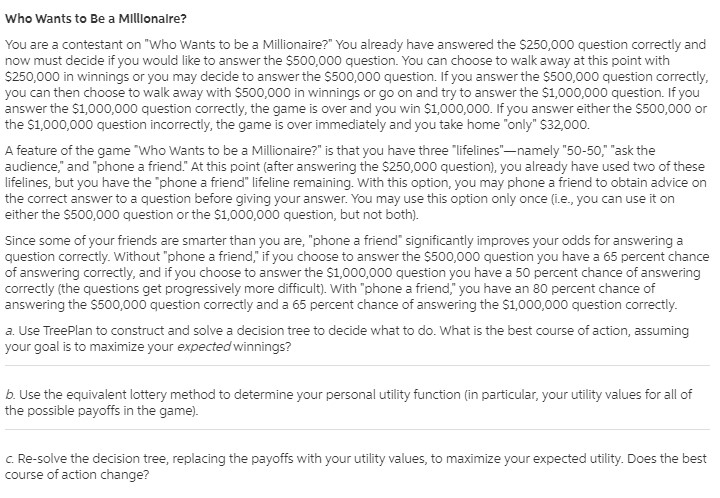
Extracted text: Who Wants to Be a Millonalre? You are a contestant on "Who Wants to be a Millionaire?" You already have answered the $250,000 question correctly and now must decide if you would like to answer the $500,000 question. You can choose to walk away at this point with $250,000 in winnings or you may decide to answer the S500,000 question. If you answer the $500,000 question correctly, you can then choose to walk away with $500,000 in winnings or go on and try to answer the $1,000,000 question. If you answer the $1,000,000 question correctly, the game is over and you win $1,000,000. If you answer either the $500,000 or the $1,000,000 question incorrectly, the game is over immediately and you take home "only" $32,000. A feature of the game "Who Wants to be a Millionaire?" is that you have three "lifelines"-namely "50-50," "ask the audience," and "phone a friend." At this point (after answering the $250,000 question), you already have used two of these lifelines, but you have the "phone a friend" lifeline remaining. With this option, you may phone a friend to obtain advice on the correct answer to a question before giving your answer. You may use this option only once (i.e., you can use it on either the $500,000 question or the $1,000,000 question, but not both). Since some of your friends are smarter than you are, "phone a friend" significantly improves your odds for answering a question correctly. Without "phone a friend," if you choose to answer the $500,000 question you have a 65 percent chance of answering correctly, and if you choose to answer the $1,000,000 question you have a 50 percent chance of answering correctly (the questions get progressively more difficult). With "phone a friend," you have an 80 percent chance of answering the $500,000 question correctly and a 65 percent chance of answering the $1,000,000 question correctly. a. Use TreePlan to construct and solve a decision tree to decide what to do. What is the best course of action, assuming your goal is to maximize your expected winnings? b. Use the equivalent lottery method to determine your personal utility function (in particular, your utility values for all of the possible payoffs in the game). c. Re-solve the decision tree, replacing the payoffs with your utility values, to maximize your expected utility. Does the best course of action change?